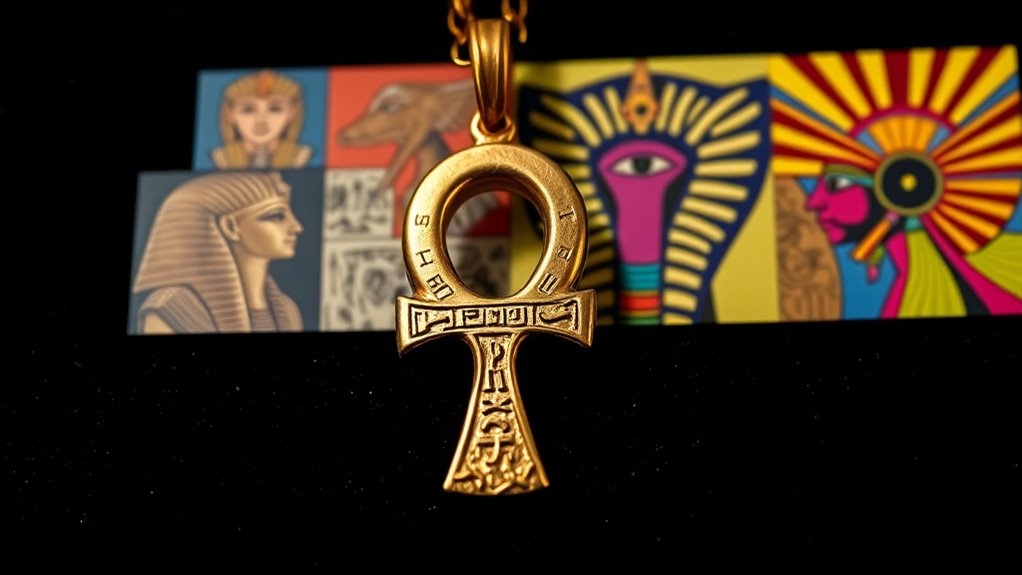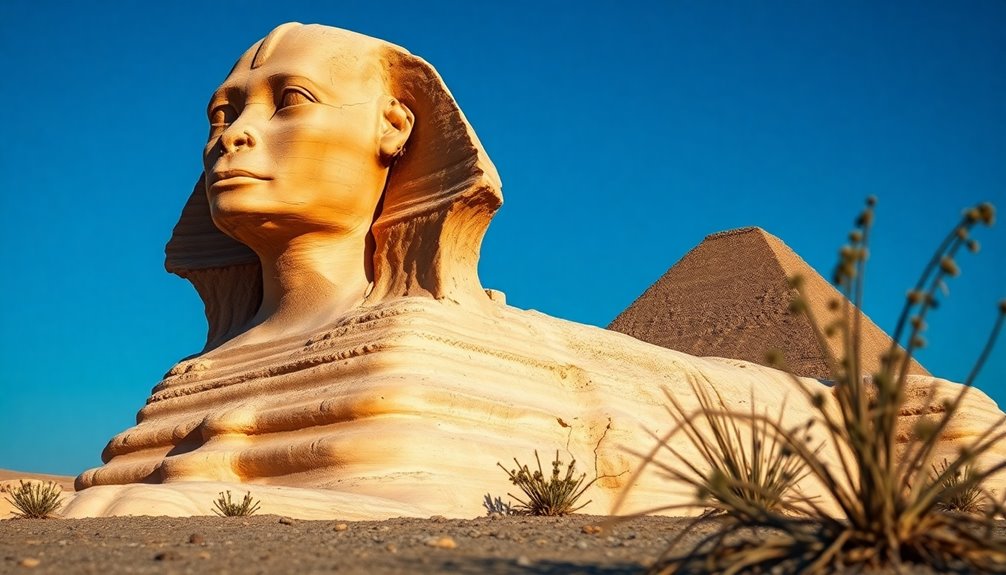The ankh, originating in ancient Egypt as a symbol of life and immortality, has evolved into a powerful pop-culture emblem. Its shape, resembling a cross with a loop, embodies vitality, renewal, and spiritual energy. Over time, it traveled through different cultures, blending with new symbols and meanings while keeping its core significance. Today, you’ll see it in fashion, art, and music, reflecting its enduring influence—discover how its story continues to unfold across history and modern life.
Key Takeaways
- The ankh originated in ancient Egypt as a symbol of life, immortality, and divine protection.
- It evolved through cultures like Greece and Rome, symbolizing rebirth and renewal in jewelry and art.
- Its core meaning of eternal life persisted, adapting to religious and cultural contexts over centuries.
- In modern times, the ankh has surged in popularity in fashion, music, and art as a spiritual and stylish motif.
- Its evolution showcases how symbols maintain their essence while morphing across eras, bridging ancient significance with contemporary relevance.

Have you ever wondered how the symbol of the ankh has evolved over centuries? This ancient symbol, often called the key of life, carries a rich history that reflects its enduring symbolic significance. Originally originating in ancient Egypt, the ankh represented life, immortality, and divine protection. Its shape resembles a cross with a loop at the top, which many believe symbolizes the union of male and female principles or the eternal cycle of life and death. Over time, the ankh’s symbolic significance expanded beyond its religious roots, becoming a universal emblem of vitality and spiritual power.
Throughout history, the ankh underwent various transformations as it traveled across cultures and eras. During the Greco-Roman period, it was sometimes incorporated into jewelry and art, often signifying rebirth and renewal. The Egyptians’ understanding of the ankh’s spiritual importance remained central, but it also took on new meanings as it fused with other cultural symbols. As Christianity spread, the ankh’s shape was sometimes mistaken for or adapted into the Christian cross, which further cemented its association with life and resurrection. Despite these changes, the core idea of eternal life persisted, illustrating how the symbol’s historical transformations kept it relevant for different audiences and contexts.
The ankh’s evolving symbolism reflects its enduring significance across cultures and eras.
In modern times, the ankh has experienced a revival, especially within pop culture. You see it in fashion, jewelry, and even music videos, where it’s often used as a stylish motif or a statement of spiritual awareness. Its symbolism resonates with people seeking connection to ancient wisdom, personal empowerment, or a sense of continuity through life’s challenges. Additionally, the cultural significance of the ankh continues to inspire contemporary art and design, blending ancient symbolism with modern aesthetics. The contemporary reinterpretation of the ankh shows how its historical transformations have allowed it to adapt and retain meaning across millennia. Whether worn as a necklace or depicted in artwork, the ankh’s enduring power lies in its ability to bridge the past with the present, embodying timeless themes of life, renewal, and spiritual energy.
Understanding the evolution of the ankh reveals more than just its changing appearance; it highlights how symbols can morph across cultures and centuries while maintaining their core essence. Its journey from an ancient amulet to a pop-culture emblem underscores its versatility and the universal human desire for connection, vitality, and transcendence. As you see the ankh today, remember that it carries the echoes of countless generations who have valued its profound symbolic significance and watched it undergo remarkable transformations over time.
Frequently Asked Questions
What Materials Were Originally Used to Create Ankh Amulets?
You might wonder what materials were used in ancient crafting of ankh amulets. Back then, artisans primarily used precious metals like gold and silver, along with faience, a glazed ceramic material symbolizing rebirth. These choices weren’t random; they carried deep material symbolism, representing wealth, power, and spiritual protection. The use of durable materials guaranteed the amulet’s significance endured, reflecting its sacred role in Egyptian culture and beliefs.
How Did the Ankh Symbolize Eternal Life in Ancient Egypt?
You might think the ankh’s shape is just decorative, but it actually symbolizes eternal life through ancient symbolism and religious significance. Some theories suggest its loop represents the eternal soul, while the crossbar signifies the horizon, linking life and death. This symbol was deeply revered in ancient Egypt, embodying the promise of immortality and spiritual continuity, making it a powerful emblem of everlasting life.
Which Modern Celebrities Have Popularized the Ankh Symbol?
You’ve probably seen the ankh symbol in modern fashion trends, thanks to celebrity endorsements. Celebrities like Lady Gaga and Rihanna have popularized it by incorporating it into their outfits and jewelry. These stars influence your style choices, making the ankh a trendy accessory. Their endorsement helps the symbol stay relevant, blending ancient symbolism with contemporary fashion, and encouraging you to embrace its powerful meaning in your own wardrobe.
Are There Any Spiritual or Mystical Meanings Associated With the Ankh Today?
You might wonder if the ankh still holds spiritual significance today. Many believe its mystical symbolism represents eternal life, spiritual renewal, and protection. Some see it as a powerful talisman for connecting with higher energies or embracing personal transformation. Its spiritual meaning continues to inspire those interested in mysticism and ancient wisdom, making it a meaningful symbol in modern spiritual practices and personal growth journeys.
How Has the Design of the Ankh Changed Over Different Historical Periods?
You notice that the ankh’s design has evolved through various periods, showcasing distinct hieroglyphic stylizations. Ancient versions feature simple, balanced loops and crosses, while later adaptations incorporate more ornate details. Cultural reinterpretations lead to diverse forms, blending traditional symbols with modern aesthetics. These changes reflect shifts in artistic styles and spiritual meanings, allowing the ankh to remain relevant across different societies and eras, evolving from a sacred symbol to a versatile cultural icon.
Conclusion
Now, as you see the ankh’s journey from ancient symbol to pop-culture icon, it’s clear how its meaning has transformed over time. You might wonder, could this small amulet really carry such a powerful legacy? Its evolution proves that symbols, like the ankh, can transcend eras, connecting past and present. So next time you spot it, remember — isn’t it fascinating how one simple shape can embody eternity, life, and rebirth across ages?










